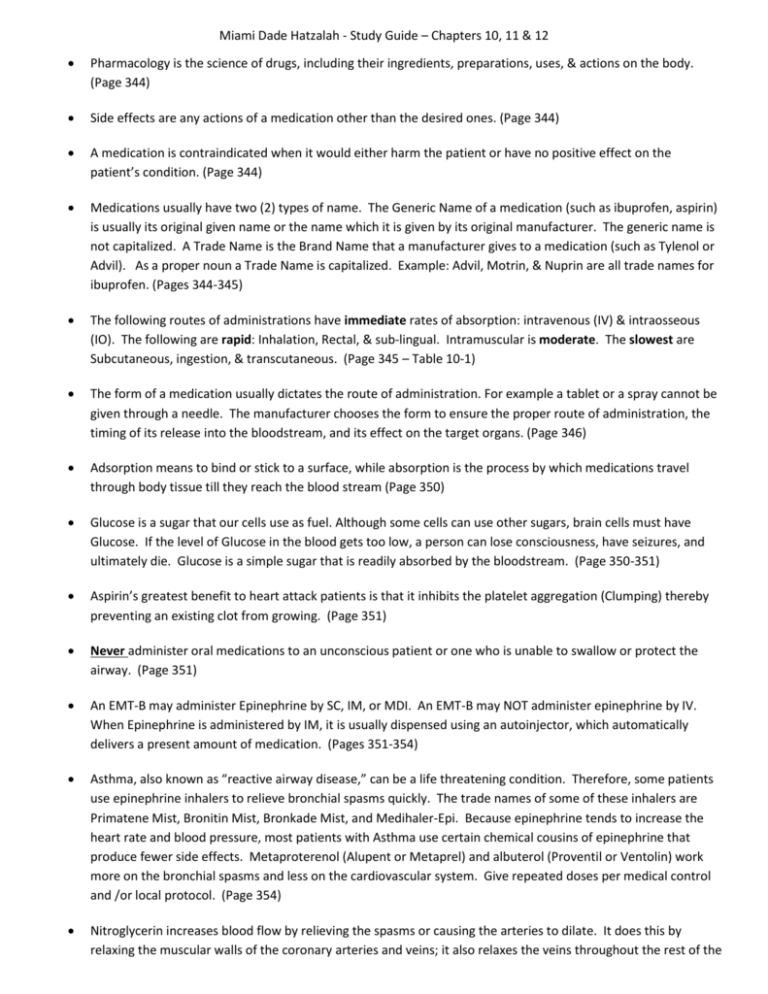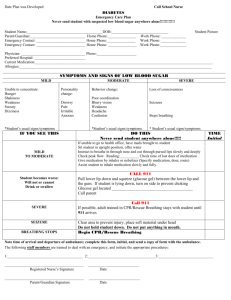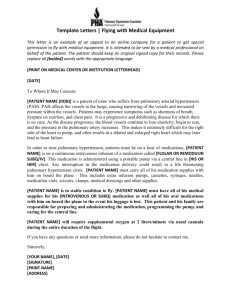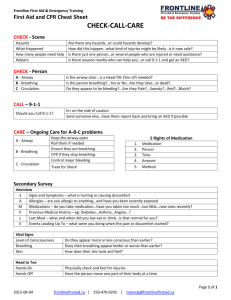Chapter1011&12Studyguide - Hatzalah of Miami-Dade
advertisement

Miami Dade Hatzalah - Study Guide – Chapters 10, 11 & 12 Pharmacology is the science of drugs, including their ingredients, preparations, uses, & actions on the body. (Page 344) Side effects are any actions of a medication other than the desired ones. (Page 344) A medication is contraindicated when it would either harm the patient or have no positive effect on the patient’s condition. (Page 344) Medications usually have two (2) types of name. The Generic Name of a medication (such as ibuprofen, aspirin) is usually its original given name or the name which it is given by its original manufacturer. The generic name is not capitalized. A Trade Name is the Brand Name that a manufacturer gives to a medication (such as Tylenol or Advil). As a proper noun a Trade Name is capitalized. Example: Advil, Motrin, & Nuprin are all trade names for ibuprofen. (Pages 344-345) The following routes of administrations have immediate rates of absorption: intravenous (IV) & intraosseous (IO). The following are rapid: Inhalation, Rectal, & sub-lingual. Intramuscular is moderate. The slowest are Subcutaneous, ingestion, & transcutaneous. (Page 345 – Table 10-1) The form of a medication usually dictates the route of administration. For example a tablet or a spray cannot be given through a needle. The manufacturer chooses the form to ensure the proper route of administration, the timing of its release into the bloodstream, and its effect on the target organs. (Page 346) Adsorption means to bind or stick to a surface, while absorption is the process by which medications travel through body tissue till they reach the blood stream (Page 350) Glucose is a sugar that our cells use as fuel. Although some cells can use other sugars, brain cells must have Glucose. If the level of Glucose in the blood gets too low, a person can lose consciousness, have seizures, and ultimately die. Glucose is a simple sugar that is readily absorbed by the bloodstream. (Page 350-351) Aspirin’s greatest benefit to heart attack patients is that it inhibits the platelet aggregation (Clumping) thereby preventing an existing clot from growing. (Page 351) Never administer oral medications to an unconscious patient or one who is unable to swallow or protect the airway. (Page 351) An EMT-B may administer Epinephrine by SC, IM, or MDI. An EMT-B may NOT administer epinephrine by IV. When Epinephrine is administered by IM, it is usually dispensed using an autoinjector, which automatically delivers a present amount of medication. (Pages 351-354) Asthma, also known as “reactive airway disease,” can be a life threatening condition. Therefore, some patients use epinephrine inhalers to relieve bronchial spasms quickly. The trade names of some of these inhalers are Primatene Mist, Bronitin Mist, Bronkade Mist, and Medihaler-Epi. Because epinephrine tends to increase the heart rate and blood pressure, most patients with Asthma use certain chemical cousins of epinephrine that produce fewer side effects. Metaproterenol (Alupent or Metaprel) and albuterol (Proventil or Ventolin) work more on the bronchial spasms and less on the cardiovascular system. Give repeated doses per medical control and /or local protocol. (Page 354) Nitroglycerin increases blood flow by relieving the spasms or causing the arteries to dilate. It does this by relaxing the muscular walls of the coronary arteries and veins; it also relaxes the veins throughout the rest of the body, so that less blood is returned to the heart and the heart has to work less. In short it reduces the blood pressure. Because of this, however, it is important that you always take the patients’ blood pressure before administering nitroglycerin. If the systolic pressure is less than 100 mm Hg, the nitroglycerin may have a harmful effect of lowering the blood flow to the hearts own blood vessels. Even a patient who has adequate blood pressure should sit or lie down with head elevated before taking this medication. If the patient is standing, he or she may faint when blood flow to the brain is reduced as the nitroglycerin start to work. If a significant drop in the patient’s blood pressure (15 to 20 mm Hg) occurs and the patient suddenly feels dizzy or sick, lay the patient down and raise the legs. It is very important to note that the medication sildenafil (Viagra) can have potentially fatal interactions with Nitroglycerin. Ask a patient who has been prescribed nitroglycerin if he has used Viagra within the previous 24 hours or if the maximum prescribed dose has already been prescribed (usually three doses). Report this to Medical Control. (Page 354-355, 415) To safely assist a patient with Nitroglycerin follows these steps: 1) Obtain order from Medical direction 2) take the patient’s blood pressure 3) Check that you have the right medication, the right patient, the right delivery route, and the expiration date 4) question the patient about the last dose he took and its effects. Prepare patient to lie down. 5) Ask patient to lift their tongue. Place tablet or spray the dose under the tongue 6) RECHECK Blood Pressure within 5 minutes and record findings. Reevaluate for chest pain and note the response of the medication. If the chest pain persists AND the patient still has a Systolic BP greater than 100 mm Hg, repeat the dose every 5 minutes as authorized by medical control. In general, a maximum of 3 doses of nitroglycerin are given for any one episode of chest pain. Nitroglycerin would also be a contraindication with patients that have experienced head injury in the past. (416). General Steps in administering medications are: 1) Obtain an Order from medical control 2) Verify the proper medication & prescription 3) Verify the form, dose, & route of the medication 4)Check the expiration date and the condition of the medication 5) Reassess the vital signs 6) document . (Pages 355-356) The right side of the heart receives oxygen-poor (deoxygenated) blood from the veins of the body. Blood enters into the right atrium from the Vena Cava, which then fills the right ventricle, blood flows into the pulmonary artery and the pulmonary circulation where the blood is oxygenated from the lungs through the pulmonary veins. Blood enters into the left atrium and then passes into the left ventricle. This side of the heart is more muscular than the other because it must pump blood into the aorta and then all the other arteries of the body. (Page 402) Normal electrical impulses begin in the sinus node, just above the Atria. The impulses travel across both the atria causing them to contract. Between the Atria and the Ventricles, the impulses cross over a bridge of special electrical tissue called Atrioventricular (AV) node. Here the signal is slowed down for 1/10 to 2/10 of a second to allow blood time to pass from the atria to the ventricles. Then the pulses exit the AV node and spread throughout both ventricles, causing the ventricular muscle cells to contract (Page 403) To carry out its function of pumping blood, the myocardium, or the heart muscle, must have a continuous supply of oxygen and nutrients. During periods of physical exertion or stress, the myocardium requires more oxygen, so the heart must increase its output of blood flow. In the normal heart, the increased needs for blood is easily supplied by dilation, or widening, of the coronary arteries, which increase blood flow. (Page 403) Most often, the low blood flow to heart tissue is caused by coronary artery atherosclerosis. Atherosclerosis is a disorder in which calcium and fatty material called cholesterol build up and form a plaque inside the walls of blood vessels, obstructing flow and interfering with their ability to dilate or contract. (Page 405) Middle-aged men, in particular are likely to minimize their symptoms of AMI (Acute Myocardial Infarction). However, a few patients, particularly older individuals, woman, or those with diabetes do not experience any pain during an AMI but will have other common complaints associated with ischemia. Others may feel only mild discomfort and call it “indigestion”. It is not uncommon for the only complaint, especially in older woman, to fatigue. (Page 409) Treat a patient with Congestive heart failure (CHF) the same way a patient with chest pain. 1) Take vital signs, monitor heart rhythm, and give oxygen by nonrebreathing mask with an oxygen flow of 10 to 15 L/Min. 2) allow the patient to remain sitting in an upright position with the legs down. 3) Be reassuring; many patients with CHF are anxious because they cannot breathe. 4) Patients who have had problems with CHF before will usually have specific medication for its treatment. Gather these medications and take them along to the hospital. 5) Nitroglycerin may be of value if the patient’s BP is above 100 mm Hg systolic. If the patients has been prescribed nitroglycerin, and medical control, or standard orders advise you to do so, you can administer it sublingually. 6) Promptly transport to the emergency department is essential. (Page 411) When clearing the patient before and AED shock, ensure the no one is touching the patient and that no object is touching the patient, including the stretcher or other furniture if the patient is not on the floor or ground (Page 422 – EMT-B Safety box) When using an AED and shock has been delivered, immediately perform CPR beginning with chest compressions. After 5 cycles (approximately 2 minutes) of CPR, reassess the patient’s pulse and reanalyze the patient’s cardiac rhythm. If the AED advises a shock, clear the patient and shock. If no shock is advised, check for Pulse. If a Pulse is present, reassess the airway and check for breathing. (Page 426) If the pulmonary arteries or veins are obstructed, it will be hard for there to be proper exchange in the alveoli sacs of oxygen and carbon dioxide to take place, it must be able to freely diffuse across the alveolar capillary membrane. (Page 366-368) When someone has an allergic reaction his airway may swell so much that breathing problems can progress from difficulty breathing to total obstruction. For some patients, the episode of anaphylaxis may represent the 1st time they were aware that they had any reaction to a substance. In this case the best solution would be to give epinephrine. (Page 374) SARS is a serious, potentially life threatening viral infection caused by a recently discovered family of viruses best known as the common cold. It usually starts with flu like symptoms. (Page 370) The brain stem senses the level of carbon dioxide in the arterial blood. The level of carbon dioxide bathing the brain stem stimulates a healthy person to breathe. If the level drops to low, a person will begin to breathe at a slower rate. If it increases then the brain stem will send messages to a healthy person to breathe more rapid. When carbon dioxide levels increase, respirations will increase in rate and depth. (Page 366-376) At the end of your Focused History and Physical Exam, and have gathered the information you need about a patient who has difficulty breathing, you would provide interventions for those problems, such as airway adjuncts, applying positive pressure ventilations with someone with shallow breathing, and placing in fowlers position or position of choice to facilitate breathing. (Page 384) The hypoxic drive is a backup system to control respirations; senses drops in oxygen level in blood, and will stimulate breathing. (Page 368) Adequate breathing includes: normal rate, a regular rise and fall movement bilaterally in the chest, and pink, warm, and dry skin. Inadequate breathing includes: unequal chest expansion, shallow reparations, skin is cool and clammy, pursed lips, cyanotic skin, and nasal flaring. (Page 367) The principal function of the lungs is respiration, which is the exchange of oxygen and carbon dioxide. The 2 processes that occur during respiration are inspiration, the act of breathing in or inhaling, and expiration, the act of breathing out or exhaling. (Page 366) Spontaneous pneumothorax is caused by a medical condition without any injury. Patients with emphysema and asthma are at high risk for this when a weakened portion of the lung ruptures, often during forceful coughing. (Page 374) When a patient is hyperventilating with no apparent medical condition, you should apply supplemental oxygen and reassure the patient in a calm professional matter. A patient may also hyperventilate with a diabetic with very high blood glucose levels, or if he overdosed on aspirin, or a patient with a severe infection. (Pages 376, 390) A pulmonary embolism is the passage of a blood clot formed in a vein, usually in legs or pelvis, that breaks off and circulates through the venous system. Can also obstruct the blood passage thereby causing decrease in circulation. (Page 375) Acute pulmonary edema is the accumulation of fluid in the space between the alveoli and the pulmonary capillaries. Some patients who have pulmonary edema do not have heart disease, but can also get it by inhaling chemicals and toxins. (Page 369, 371) When assisting with a MDI, tell the patient to fully exhale before inhaling, and afterwards to hold his or her breath for as long as he/she can comfortably can to help the body absorb the medication.(Page386-387) Wheezing is generally a high pitched whistling or crackling sound, most often heard on exhalation, but sometimes on inhalation. When dealing with a patient with trouble breathing and he/she calls for help, find out if they have a prescribed MDI. (Pages 381,385) When a person is going into shock the organs of the body begin to malfunction and the blood pressure will fall below normal. A systolic blood pressure less than 90 mm Hg is easy to recognize, but it is a late finding that indicates decompensated shock. Do not assume shock is not present just because the blood pressure is normal. (Page 411) In a cardiac emergency, depending on the local protocol, prepare to administer aspirin. Baby aspirin comes in 81-mg chewable tablets. Recommended dosage is often 162mg (two tablets) or 324 mg (four tablets). Aspirin (acetylsalicylic acid) prevents clots from forming or getting bigger, but be sure to first get permission from medical control. (Page 415) Signs and symptoms of a heart attack include: chest pain, hypertension, high cholesterol, diabetes mellitus, crushing pain, sudden weakness, nausea, and sweating without an obvious cause. A lot of times you’ll find patients who are experiencing the symptoms of an AMI but they brush it off as being something a lot lighter than it is, and would not call for any medical help. (Page 408) One of the heart surgeries that patients might have is what’s known as PTCA- percutaneous translumial coronary angioplasty, in which a tiny balloon is attached to the end of a long thin tube. The tube is introduced through the skin into a large artery, usually in the groin, and then threaded into the narrowed coronary artery, with radiographs serving as a guide. Once the balloon is in position inside the coronary artery, it is then inflated. The balloon is then deflated, and the tube is removed from the body. (Page 418)







